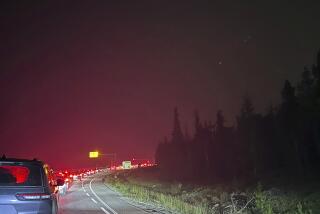Beyond the Mounties’ red uniforms
- Share via
REGINA, CANADA — The Canadian Mountie museum here in the barren plains of Saskatchewan doesn’t pander to Hollywood images such as Dudley Do-Right and Sergeant Preston of the Yukon. Yes, for special assignments, they really do wear those felt hats, scarlet tunics, and baggy pants known as breeches. But this place is much more about honoring the tradition of the men who brought law and order to a harsh land than about reinforcing stereotypes.
A repository for more than 35,000 artifacts, the RCMP Heritage Centre documents the history of the Royal Canadian Mounted Police, from the inception of the North West Mounted Police in 1873 to the sophisticated anti-terrorist squads of the 21st century.
The museum -- less than 2 years old -- sits on the grounds of the RCMP Academy. Called “the cradle of the force,” this is where recruits from across Canada do their basic training. Visitors to the museum are invited to take an escorted tour of the training facilities.
The first stop is the academy’s chapel. Built in 1883, it’s the oldest building in Regina, the genteel provincial capital (population 190,000) about 100 miles north of the U.S. border. The chapel was built as a mess hall, and after a hard day’s work early cadets could belly up to the canteen for beer at 5 cents a pint.
For guests who time their visit right, the highlight of their day will be the Sergeant Major’s Parade. At 12:45 p.m. each weekday, hundreds of recruits march onto the parade ground -- or, in bad weather, into the drill hall -- to practice maneuvers as their instructors bark commands over the music being played by a police band. On Tuesday evenings from July 1 to mid-August, visitors can also witness the pageantry of the Sunset Retreat, during which the troops parade in their dress red uniforms.
A truly national police force, the RCMP has no equal in the U.S. It’s like the local sheriff, the highway patrol and the FBI, all in one department.
“I carried the duties as commissioner for oaths, as well as justice of the peace, coroner [and] keeper of the common gaol [jail],” says John Worthington, a retired Mountie who now volunteers as a docent, sharing his experiences and knowledge with museum visitors.
Worthington, who grew up on a farm outside Toronto, enjoys sharing the tales from the assignment that first brought him to Saskatchewan as the only constable in the village of Cumberland House, a bleak and often frigid outpost on an island in the Saskatchewan River a few hundred miles north of Regina. He, his wife and 2-year-old son were among only a handful of non-native residents.
“It was quite a cultural shock,” recalls Worthington.
“The only road into Cumberland House stopped at the river, and you took a ferryboat across to the island.”
With the help of a local Metis Indian guide, Worthington policed more than 5,000 square miles. During the long winters, they traveled either by dog sled or in a large, enclosed snowmobile capable of carrying several passengers.
The vehicle lumbered across the frozen terrain on large tracks similar to those on a tank or a bulldozer. The steering wheel was connected to skis mounted under the front seat.
One of these curious, but practical, contraptions is displayed inside the museum. The giant snowmobile helps Worthington explain the difficult life an outsider -- let alone a lawman -- faced in the frozen north.
Other favorites of his include the last dog sled used by the RCMP and a large painting depicting a manhunt in the wilds of the Yukon.
The constable in the painting is dressed in a heavy, fur-trimmed parka, breeches and mukluks -- an outfit very familiar to the museum guide.
Such pants and parka were regulation-issue, but Worthington got his deerskin boots from the locals.
“You can get First Nations people to make you a pair,” he explains. “And providing you don’t get them wet, you can travel very quickly and quite nimbly over the snow, because of the lightness of the mukluk itself.”
--
--
BEGIN TEXT OF INFOBOX
Have a royal time in genteel Regina
THE RCMP HERITAGE CENTRE
in Regina, Saskatchewan, is open seven days a week. Admission is $12 (Canadian) for adults, with a sliding scale for children under 18; (866) 567-7267, www.rcmpheritagecentre.com.
Government House is just down the road. It is the stately former residence of the queen’s representative in these parts. Tours are offered Tuesday through Sunday year-round; (306) 787-5773, www.ops.gov.sk.ca/govhouse.
Hotel Saskatchewan is Regina’s premier choice for lodging. Rooms start at $153 (Canadian), double occupancy; (306) 522-7691, www.hotelsask.com.
More information, contact the provincial tourist office (877) 237-2273; www.sasktourism.com.
More to Read
Sign up for The Wild
We’ll help you find the best places to hike, bike and run, as well as the perfect silent spots for meditation and yoga.
You may occasionally receive promotional content from the Los Angeles Times.






